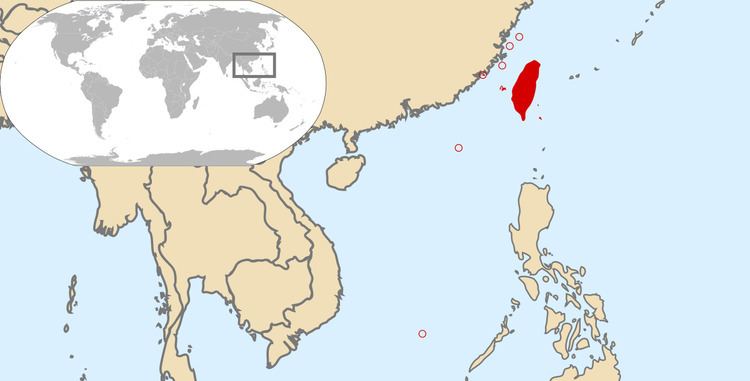Native speakers 10,500 (2002) | Ethnicity Rukai | |
 | ||
Region Pingtung CountyKaohsiung CountyTaidong County Language family AustronesianFormosanRukai Dialects BudaiLabuanMagaMantauranTananTona | ||
Rukai is a Formosan language spoken by the Rukai people in Taiwan. It is a member of the Austronesian language family. The Rukai language comprises six dialects, which are Budai, Labuan, Maga, Mantauran, Tanan, and Tona. The number of speakers of the six Rukai dialects is estimated to be about 10,000. Some of them are monolingual. There are varying degrees of mutual intelligibility among the Rukai dialects. Rukai is notable for its distinct grammatical voice system among the Formosan languages.
Contents
Classification
Paul Jen-kuei Li considers Rukai to be the first language to have split from the Proto-Austronesian language. Below are the estimated divergence dates of various Formosan languages from Li (2008:215).
- Proto-Austronesian: 4,500 BCE
- Rukai: 3,000 BCE
- Tsouic: 2,500 BCE (split into Tsou and Southern Tsouic around 1,000 BCE)
- Most other splits: 2,000 to 0 BCE
- Western Plains: 1,000 CE
Classifications by various scholars repeatedly find that Rukai is one of the, and often the, most divergent of the Austronesian languages. It is therefore prime evidence for reconstructing Proto-Austronesian. Ross (2009) notes that to date, reconstructions had not taken Rukai into account, and therefore cannot be considered valid for the entire family.
Dialects
Rukai is unique for being the only Formosan language without a focus system.
Tanan Rukai is also the Formosan language with the largest consonant inventory, with 23 consonants and 4 vowels having length contrast. Tanan Rukai also makes an animate/inanimate instead of a personal/non-personal one as most other Formosan languages do.
Mantauran is one of the most divergent dialects. Li (2001) classifies them as follows:
Geographic distribution
According to Zeitoun (2007:4), there are a total of 6 Rukai dialects spoken in 12 different villages.
Together, Maga, Tona, and Mantauran are also known as the "Lower Three Villages." Rukai have also recently in Sandimen Township and southern Sanhe Village, Majia Township, where there are many Paiwan. Sanhe Village is also where the Budai Rukai originally lived in before they relocated to Wutai Township in the mid-1900s.
Phonology
Most Rukai dialects have four vowels and retroflex and interdental consonants.
Budai Rukai has four vowels, /i ə a u/. /ə/ is not a schwa but a full vowel. Words ending phonemically in a consonant add an echo vowel, one of /i ə u/, which unlike morphophonemic vowels is often lost in derivation. /ə/ is used when the last vowel of the stem is /a/.
Due to influence from Paiwan and Chinese, younger speakers sometimes pronounce /ð/ as [z], and in Tanan Rukai, younger speakers may merge /θ/ into /s/.
In Mantauran Rukai, the voiced stops have spirantized: *b to /v/, *d and *ɖ to /ð/, and *g to /h/.
The following table displays the consonant inventory of Mantauran Rukai, with written representations that differ from their IPA representations given in angle brackets (Zeitoun 2007):
Morphology
Basic Mantauran Rukai syllables take on a basic (C)V structure, with words usually ranging from 2 to 4 syllables long (Zeitoun 2007). There are four morphological processes.
- Affixation
- Stem modification
- Reduplication
- Compounding
The following reduplication patterns occur in Budai Rukai (Austronesian Comparative Dictionary).
In Budai Rukai, reduplication of a bound stem can also be used to create certain basic nouns and verbs, such as 'thunder,' 'mountain,' and 'to scrape' (Austronesian Comparative Dictionary).
Budai Rukai is unusual among Formosan languages for not having a dichotomous active/passive voice system rather than the more elaborate voice system found in the rest of the Formosan languages, which may include voices such agent, patient, locative, or instrumental focus. Stan Starosta considers this to be an indication that Rukai is the first offshoot of the Austronesian language family. (Zeitoun 2007).
Syntax
Unlike most other Formosan languages, Rukai has an accusative case-marking system instead of an ergative one typical of Austronesian-aligned languages (Zeitoun 2007). There are two types of clauses in Mantauran Rukai:
- Nominal
- Verbal
Complementalization can take on four strategies (Zeitoun 2007).
- Zero strategy (i.e. paratactic complements)
- Verb serialization
- Nominalization
- Causativization
Definite objects can be topicalized in both active and passive sentences.
Function words
Below are some Mantauran Rukai function words from Zeitoun (2007).
Word classes
Zeitoun (2007) distinguishes eleven word classes in Mantauran Rukai:.
- Nouns
- Verbs
- Pronouns
- Demonstratives
- Numerals
- Adverbs
- Phrasal elements
- Clausal elements
- Interclausal elements
- Exclamations
- Interjections
Verbs
Below are some Mantauran Rukai verb affixes from Zeitoun (2007).
Pronouns
Below are Rukai pronouns from Zeitoun (1997). Note that Mantauran Rukai pronouns are usually bound.
Budai Rukai
The list of Budai Rukai affixes below is sourced from Chen (2006:199-203).
Prefixes
Suffixes
Infixes
Circumfixes
Compound (Multiple) Affixes
Mantauran Rukai
The following list of Mantauran Rukai affixes is sourced from Zeitoun (2007).
The following list of Budai Rukai affixes is sourced from the Comparative Austronesian Dictionary (1995).
